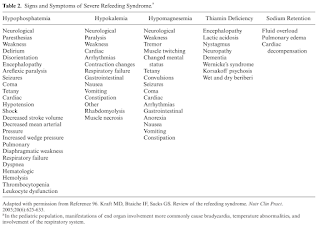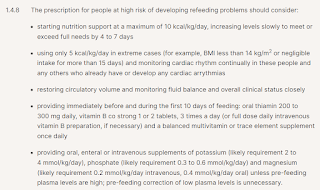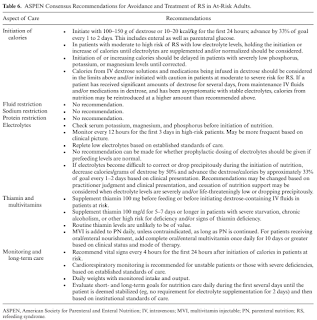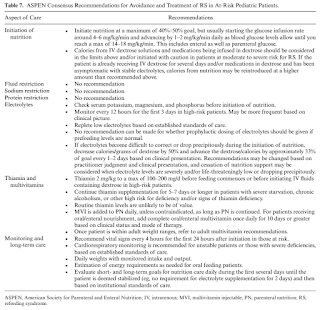Refeeding Syndrome
Introduction
Refeeding syndrome is a potentially life-threatening condition that occurs from rapid refeeding of malnutrition patients using high-calorie, high-carbohydrate formulations after a period of decreased or absent calorie intake.
- During a period of starvation, various electrolytes are lost and there is compensatory movement of the electrolytes (e.g. magnesium, calcium and phosphate) from the cells into the plasma to maintain near-normal plasma levels.
- When feeding recommences, there is an increase in insulin production that causes these electrolytes to move intracellularly and their serum concentrations consequently fall.
Signs and Symptoms
Symptoms generally appear within 2-5 days of re-feeding and may be absent/mild or severe and life-threatening.
- The hallmark biochemical feature of refeeding syndrome is hypophosphatemia.
- However, the syndrome is complex and may also feature hypokalemia, hypomagnesaemia, hypocalcaemia, fluid retention and there may be a thiamine deficiency, particularly if the patient has a history of alcohol abuse.
In summary, refeeding syndrome derives from an abnormal electrolyte and fluid shifts leading to many organ dysfunctions.
Risk of Refeeding Syndrome
In 2006, the National Institute for Health and Clinical Excellence (NICE) guidelines reported the risk factors to identify people at low or high risk for refeeding syndrome. In 2018, Friedli et Coll added the very high-risk category. In 2020, the American Society for Parenteral and Enteral Nutrition (ASPEN) published updated consensus criteria for identifying adult patients at risk for refeeding syndrome.
ASPEN Consensus Recommendation, 2020
- In the absence of a universally accepted definition for refeeding syndrome, the incidence is unknown. Thus, any quantification of risk is not currently possible.
- There are a few important differences between the adult and paediatric populations.
- Adults are believed to be more tolerant to longer periods of starvation. Short periods of nutrient deprivation may have a more significant effect in children because of the added metabolic demands of growth. For this reason, the paediatric criteria include a “mild risk” level.
- The velocity of weight gain, current height and length, current weight-for-length, or BMI-for-age z-score should be considered when assessing children for their risk of refeeding syndrome.
Avoidance of Refeeding Syndrome
NICE Guidance, 2017
ASPEN Consensus Recommendation, 2020
NOTE: There is poor consensus and conflicting research to drive decisions related to feeding rates for avoiding refeeding syndrome.
External Links
- NICE - Nutrition support for adults: oral nutrition support, enteral tube feeding and parenteral nutrition, 2017
- Management and prevention of refeeding syndrome in medical inpatients: An evidence-based and consensus-supported algorithm, 2018
- ASPEN Consensus Recommendations for Refeeding Syndrome, 2020
- The Refeeding Syndrome: a neglected but potentially serious condition for inpatients. A narrative review, 2020
- Cleveland Clinic - Refeeding Syndrome









Comments
Post a Comment